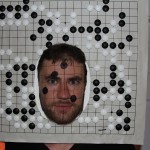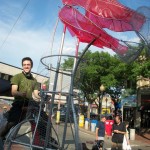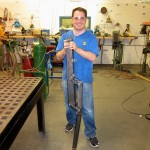What
Project Hexapod is a team of 19 roboticists, engineers, designers, and fabricators who are building a 4,000 pound, 18 foot diameter rideable 6-legged robot and release the designs to the world. We don’t just want to build a giant robot, we want to enable others to build giant robots. This blog is the official source for news on our efforts.
How
It turns out that when you break robots down into component pieces, they’re actually pretty easy to design and make. Each subsystem of a robot (whether we’re talking about the hydraulic, mechanical, electrical, or computational subsystem) has its own design style, fabrication or implementation gotchas, and best practices, but in general there are no particularly hard problems for relatively simple robots like hexapods. The challenge comes when you add up all the simple things and find yourself on top of a mountain of things to keep track of and do. Furthermore, there are some big systems-level decisions you have to make early and correctly, or else you’ll end up going down a path that just won’t pan out.
Our hypothesis here is that giant robots are simple enough, if you divide them up into suitably sized chunks and if you pick functional systems at the outset, to have designers, fabricators, and engineers who don’t come from a robotics background put one together with enough careful instruction and project management. We’re here to prove that there’s a whole new way of taking on giant, collaborative projects, and we’re doing it by building the coolest robot you’ve ever seen. Check out our blog for design and build updates as time goes on!
Who
Founders (alphabetically):

Gui Cavalcanti received a General Engineering degree with a Robotics concentration from the Olin College of Engineering. He worked as a robotics engineer and systems integrator at a high end Boston-area robotics company, working primarily on cutting edge mechanical design and systems integration for robotic systems. Over the course of his career he has also developed the mechanical systems for a robotic tuna, several robotic snakes, an ornithopter, and several other robotic animals. In his spare time he builds ridiculous things with ridiculous people, like a flotilla of SUV-sized rubber duck boats to take on the water on the 4th of July. He co-founded and currently runs Artisan’s Asylum, the 31,000 square foot makerspace where the project is being built.

Dan Cody is a Programmer and Controls Engineer from the Olin College of Engineering. Controls code he wrote has been demonstrated on the Colbert Report, in a temporary exhibit at The Smithsonian, at this year’s Consumer Electronics Show in Las Vegas, and at numerous robotics conferences across the US, Europe, and Asia. He works at Barrett Technology, a 20-person company that specializes in making advanced robotic arms and hands that are designed to interact with humans. Dan is the designer and primary author of libbarrett, the open-source, real-time controls library that runs Barrett’s products. Before Barrett, Dan worked for DEKA, the R&D company most famous for creating the Segway. He developed some of the novel user-input methods that are used to control DEKA’s upper limb prosthetic, known as the Luke Arm. On the weekends, look for him dangling from the end of a rope half-way up the nearest cliff.

James Whong is a renaissance man in training with a degree in Electrical Engineering from Olin College. He’s a professional roboticist at a high end Boston-area robotics company, working on networked electrical power distribution and communication systems. Before that, he wrote software and designed circuits for DEKA Research & Development, Vision Robotics, and ENSCO Engineering’s DARPA Grand Challenge vehicle.
Team Members (alphabetically):
Adam Bercu

M@ Dunlap is a roboticist and grad student at Tufts University. Previously he has worked as a software engineer at Google, a waiter at Denny’s, and a plethora of other things in between. His interests are along the lines of artificial intelligence, philosophy, nature photography, wandering aimlessly in foreign cities, gizmos, and getting trounced at Go (13k). Which sounds impressive and all, but he also actually enjoys climbing mountains, going more than a little too fast on motorcycles, and wearing flipflops strait through Boston winters, so the matter of his sanity is really anyone’s guess.
Max Eskin

Spark is a tinkerer and adventurer. He works as an electrical engineer. In his free time he enjoys messing around with electronics and robotics projects, making metal sculptures, and fire dancing.

MacConnell Evans is a Bowdoin-taught Mathematician/Physicist with a recent Masters degree in Mechanical Engineering. His research involved biomimickery of the face using the FACS coding system with a combination of servo motors, an Arudino, and some serious crafting. His work has culminated in creating a small robotic face that will emulate certain facial expression at an anatomical level with the hope of future prototypes of increasing complexity. Being a new amateur freelance roboticist, he hopes this class will give him more experience in the field.
Jeff Jackson
Joel Greenwood
Andy Haycox

Benjamin Hitov likes writing code and cuddling puppies. He is a volunteer Ninja at CareerVillage, eliminates potholes with mathematics, and hooks batteries up to his brain for SCIENCE. For earth credits he engineers software at a neurotech startup and runs TechBloom Labs, a humble web dev shop. He thinks life is pretty awesome and would like to help everyone else feel similarly. *Hugs* <3
Mycroft has been writing free software for more than 30 years, including cofounding and nurturing the NetBSD project for many years. Currently he writes cloud computing software for moola. His inspirations for ridiculous robot projects are Survival Research Labs and Robosaurus. He has visions of making a giant robot dance.

Jona Raphael
Jona is an informaholic. He has been known to lose entire days to wikipedia, and does his best thinking through analogies. Googling should be on his resume. He believes that a well-understood problem is a solvable one, and he remains in endless awe of the human experience while striving to make a difference through humanitarian efforts. In his spare time, he climbs rocks, juggles clubs, and floats unusually heavy objects on the Charles River.
George Sass
Joseph Schlesinger was trained as an electrical and computer engineer at Worcester Polytechnic Institute, daylights as a programmer, moonlights as a roboticst, and is 24/7 up to mischeif. Founder of a hackerspace and an open-source robotics company, he’s always up for advancing the idea of the moment, whether that be driving toddlers on 200lb steel robots, injecting live current through his brain, or cracking online fantasy game financial systems with wall-street style analytics.

Michael Soroka may or may not have launched a potato into orbit. He might have built the worlds first autonomous gingerbread robot. It has been said that he created an invisible robot submarine made entirely out of glass, but that sounds made up.
Daniel Walkswithstick is a recent BS graduate from Northeastern University with a degree in Electrical Engineering. He had spent the first part of his career life as a construction worker in New York City before moving to Boston. Now, he has a strong interest in robotics and is looking forward to starting a PhD program at NU in robotics distributed control this coming fall.

Aidan Zimmerman
Aidan Zimmerman has always been interested in life, the universe, and everything. He fell in love with robots and engineering at the age of 4 after watching a MIT robotics competition with is grandfather. He received his first set of power tools in second grade, and later, two degrees in Mechanical Engineering (with all of his fingers still intact) from RPI with his masters thesis focused on 3D printing with chocolate. Aidan now develops thermal vision, night vision, and laser products for the defense sector. In his spare time he brews his own beer, exercises his cats using a laser pointer, tinkers on his restored bridgeport mill, and gets his robotics fix by hanging out at Artisan’s Asylum.
Go Olin!
Let’s not stop here. Stompy II must float and have paddles on it’s “legs”. Oh yes, paddles.
Currently it will be able to ford a river up to 6 or 7 feet deep. Perhaps an intermediate goal should be giant robot water wings?
…..empty pontoons for flotation, could also be used as extra fuel tanks, or even water, for long desert excursion.
Interesting, You (Your Team) Appear to be building a two passenger version of one of the early prototype designs for the Mars probe. The one they,(NASA) were testing in the active volcano. Have you thought about weight displacement at the leg contact point? On t.v. they are advertising a sort of articulated cane, the “HURI-CANE” if I remember correctly, it’s base is free floating, until it makes contact, then locks in tight at various angles. this will prevent slippage, and damage to soft surface areas. Also by using a leg “PAD” you can increase the weight displacement through area contact size, as you increase the weight. This is just one of many Ideas “Bloggin in me noggin'” Feel free to incorporate these design ideals into your concept vehicle, and one last thing, “Shotgun”, that’s right I called it.
I like what you guys are usually up too. Such clever work and exposure! Keep up the fantastic works guys I’ve you guys to my own blogroll.